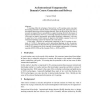Free Online Productivity Tools
i2Speak
i2Symbol
i2OCR
iTex2Img
iWeb2Print
iWeb2Shot
i2Type
iPdf2Split
iPdf2Merge
i2Bopomofo
i2Arabic
i2Style
i2Image
i2PDF
iLatex2Rtf
Sci2ools
BXML
2003
2003
An Instructional Component for Dynamic Course Generation and Delivery
: E-Learning offers the advantage of interactivity: an E-Learning system can adapt the learning materials to suit the learner’s personality and his goals, and it can react to the students interaction with the learning materials. Since the advent of the Web, lots of research investigated the new possibilities to support learning offered by the means of hypertext and the Internet. However, even though important results have been achieved with respect to adaptive hypermedia, open student modeling, collaborative web-tools to name but a few, current features of adaptivity fall behind compared to pre-web instructional planning systems developed in the early nineties. In this paper, I describe an instructional component for the E-Learning environment ACTIVEMATH that marries work in instructional planning, on how to generate learning materials that are best suited for an individual learner and his tasks, and recent work for E-Learning in the Web, especially in knowledge representation, of le...
| Added | 31 Oct 2010 |
| Updated | 31 Oct 2010 |
| Type | Conference |
| Year | 2003 |
| Where | BXML |
| Authors | Carsten Ullrich |
Comments (0)

